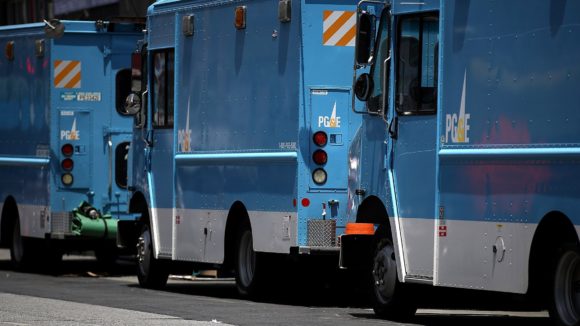California utility giant PG&E Corp. has issued its long-awaited plan for emerging from the largest utility bankruptcy in U.S. history: Raise debt, offer equity and cap wildfire liabilities that led to its collapse at $18 billion — less than half of what victims and insurers want.
The plan has already sparked outrage.
The proposal is “a fraction of what wildfire victims would need to rebuild their lives,” said Patrick McCallum, who co-chairs a group representing victims of blazes that PG&E’s equipment has been blamed for sparking. The fires destroyed tens of thousands of structures across Northern California in 2017 and 2018, killed more than 100 people and buried the company in so many legal claims it was forced to file for Chapter 11 in January.
PG&E shares fell 5%, to $10.61, at 10:33 a.m. in New York.
The plan it submitted in federal court Monday kicks off the most contentious phase yet of a bankruptcy that’s attracted some of the biggest names in the financial world, including Pacific Investment Management Co. and Elliott Management Corp. Since the company’s collapse — what’s been described as climate change’s largest financial casualty to date — wildfire victims, state politicians, activist investors and ratepayer advocates have clashed over the company’s future.
PG&E Chief Financial Officer Jason Wells described the company’s plan on Monday as a “crucial step in a multistep process” and said it may eventually be revised, depending on what the courts find the company legally responsible for paying.
Under the proposal filed Monday, PG&E would:
- Establish two trusts to cover its wildfire liabilities:
- One for insurers capped at $8.5 billion. (They’ve claimed they’re owed $18 billion.)
- One for wildfire victims capped at $8.4 billion. (Victims’ attorneys have said claims may top $40 billion.) That doesn’t include a $1 billion settlement the company has already reached with some local agencies.
- Raise more than $30 billion in debt and equity, including a share offering of as much as $14 billion.
- Assume all existing long-term power purchase agreements.
- Pay all pre-bankruptcy debt, trade and employee claims.
- Assume employee benefits and obligations.
- Participate in a statewide wildfire fund, created to help cover the costs of future blazes, with an initial payment of $4.8 billion.
“It’s a framework,” Wells said.
Mike Danko, a lawyer representing wildfire victims, called the plan “dead on arrival.”
Wildfire Estimates
Complicating PG&E’s proposal is the fact that claims tied to the blazes are getting tallied in a separate court process that’s only begun. While the company has given estimates, it may be months before a clear picture of the liabilities emerges.
Any exit plan hinges on that estimate. The official tally could lead to an entire rewrite of PG&E’s reorganization. A total that’s higher than PG&E is capable of paying threatens to wipe out current shareholders since, under the U.S. Bankruptcy Code, fire victims would be paid in full first.
That puts PG&E in a tenuous position as key creditor groups clamor to pitch their own restructuring proposals to U.S. Bankruptcy Judge Dennis Montali. In August, Montali said he doesn’t expect PG&E’s plan to be the final since some details aren’t yet available. But he said the company must present something credible or else he may open the door to rival ones.
Meanwhile, time is running out for PG&E. The company has until June to get out of bankruptcy if it wants to participate in a fund recently established by California to help utilities cover the cost of future fires. The alternative is facing the prospect of another catastrophic blaze that could force it into financial ruin once again.
Hitting Snags
PG&E’s plan has already hit some snags: A group led by Pimco and Elliott have been floating one plan that would all but wipe out the stakes of current stakeholders and hand control of the company over to them. They’ve fought to have their proposal considered by Montali. PG&E shareholders would keep their current holdings under the company’s plan, but their stakes may be significantly diluted by new shares issued.
In addition, PG&E’s reorganization plan may not be as favorable to some debtholders as an earlier one proposed by bondholders, Jaimin Patel, a credit analyst at Bloomberg Intelligence, wrote in a note Tuesday. The company proposes repaying debt with full pre- and post-petition interest — but it doesn’t include any “make-whole provisions,” he said.
On Sept. 6, a measure that would’ve allowed the company to use tax-free state bonds to pay off its fire claims stalled in California’s legislature. And San Francisco is offering to buy some of the utility’s local electrical assets for $2.5 billion. The city — PG&E’s hometown — sees the deal as an opportunity to save ratepayers money and fulfill its long-held desire to break away from the company.
Click here to view the report.
PG&E filed its plan without an outline that describes in plain terms how creditors will be treated. That outline, known as a disclosure statement, typically helps creditors decide how to vote on the reorganization. Montali permitted PG&E to put off filing it.
The case is PG&E Corp., 19-bk-30088, U.S. Bankruptcy Court Northern District of California (San Francisco)
Was this article valuable?
Here are more articles you may enjoy.


 Singer’s Elliott Sued by PE Firm in Escalating Fight Over Money
Singer’s Elliott Sued by PE Firm in Escalating Fight Over Money  JPMorgan Wins Gender Pay Gap Dispute Against London Analyst
JPMorgan Wins Gender Pay Gap Dispute Against London Analyst  Munich Re: Insured Losses From Wildfires, Storms and Floods Hit Record High
Munich Re: Insured Losses From Wildfires, Storms and Floods Hit Record High  Storm Goretti Batters Europe With Violent Winds, Power Cuts
Storm Goretti Batters Europe With Violent Winds, Power Cuts 